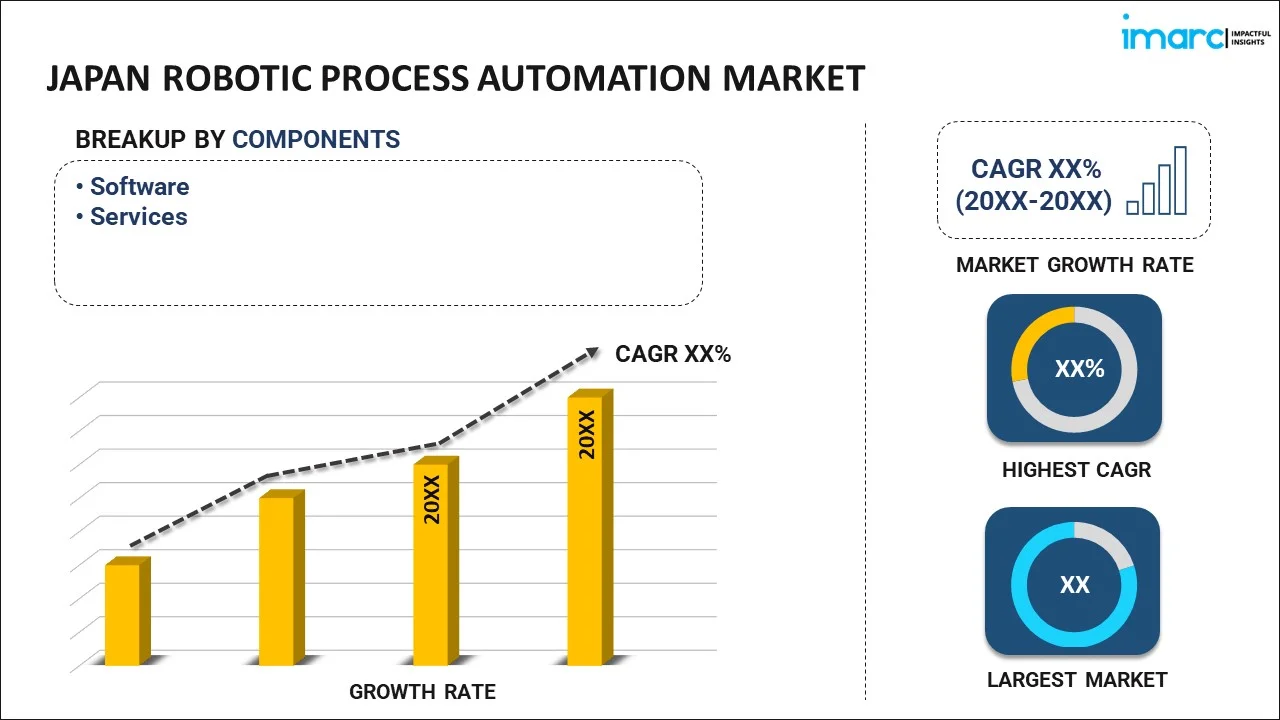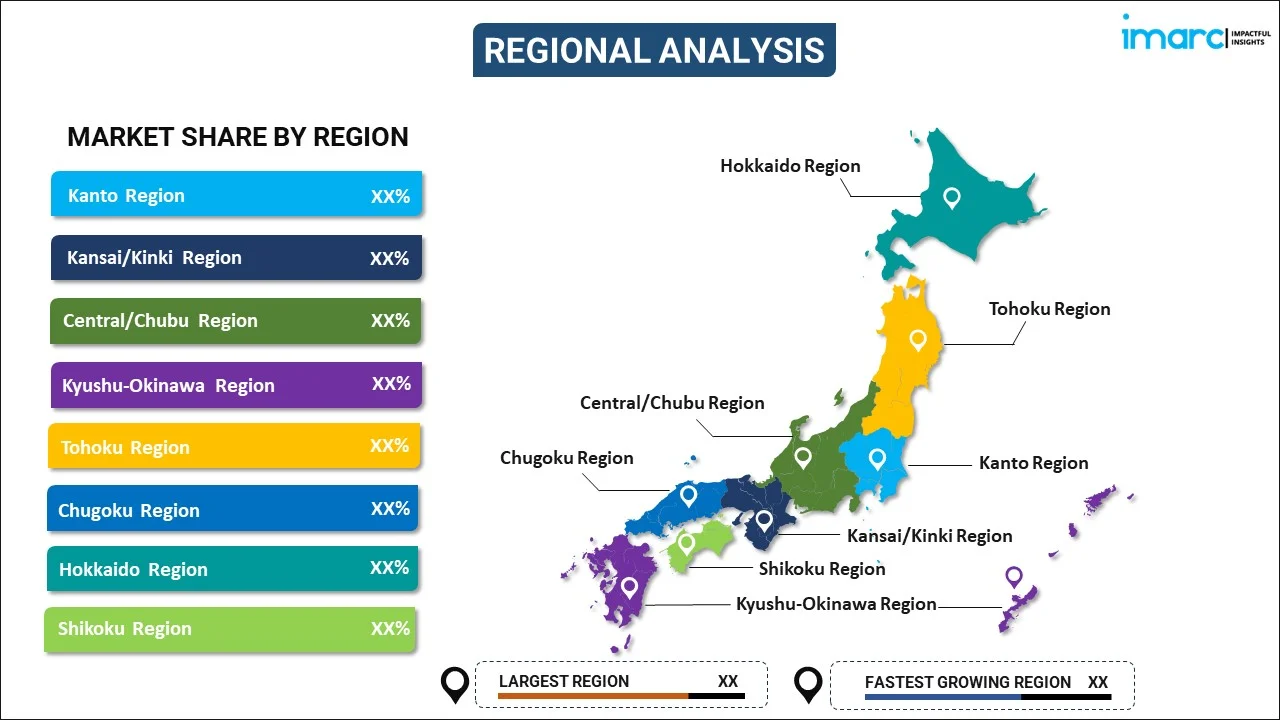
Japan Robotic Process Automation Market Report by Component (Software, Services), Operation (Rule-based, Knowledge-based), Deployment Model (On-premises, Cloud-based), Organization Size (Large Enterprises, Small and Medium Sized Enterprises), End User (BFSI, Healthcare and Pharmaceuticals, Retail and Consumer Goods, IT and Telecommunication, Government and Defense, Transportation and Logistics, Energy and Utilities, and Others), and Region 2025-2033
Market Overview:
Japan robotic process automation market size reached USD 735 Million in 2024. Looking forward, IMARC Group expects the market to reach USD 5,091.0 Million by 2033, exhibiting a growth rate (CAGR) of 24.0% during 2025-2033. The increasing demand for automation in manufacturing across Japan, rapidly aging workforce, growing awareness among Japanese businesses, rising digital transformation initiatives across industries, and the integration of advanced technologies represent some of the key factors driving the market.
|
Report Attribute
|
Key Statistics
|
|---|---|
|
Base Year
|
2024
|
|
Forecast Years
|
2025-2033
|
|
Historical Years
|
2019-2024
|
|
Market Size in 2024
|
USD 735 Million |
|
Market Forecast in 2033
|
USD 5,091.0 Million |
| Market Growth Rate 2025-2033 | 24.0% |
Robotic process automation (RPA) refers to a technology that utilizes software robots or 'bots' to automate repetitive, routine tasks that are traditionally performed by human workers. It operates by mimicking the actions of a human interacting with digital systems to execute business processes. RPA can log into applications, enter data, calculate, complete tasks, and then log out. It is characterized by its ability to integrate various technologies like artificial intelligence (AI), machine learning (ML), and workflow automation. RPA is comprised of various components, such as software, bots, and a control dashboard for management. It possesses several features, including non-invasiveness, scalability, and reliability. RPA finds applications in a wide array of industries and sectors, including finance, healthcare, telecommunications, manufacturing, insurance, customer service, and human resources. It aids in reducing operational costs, increasing efficiency, improving accuracy, ensuring compliance, enhancing customer experience, boosting employee satisfaction, and optimizing strategic workforce allocation. In addition, RPA is known for its cost-effectiveness, flexibility, non-disruptiveness, ease of use, rapid return on investment (ROI), and minimization of errors.
Japan Robotic Process Automation Market Trends:
The increasing demand for automation in manufacturing across Japan to improve efficiency and productivity is propelling the market growth. Additionally, the rapidly aging workforce, which is creating a gap in labor, is driving the market growth. Besides this, the growing awareness among Japanese businesses about the benefits of RPA in terms of cost reduction and operational efficiency is creating a positive outlook for the market. Furthermore, the rising digital transformation initiatives across industries in Japan are fostering the market growth. In addition, the ongoing government push towards promoting the integration of digital technologies into various sectors is catalyzing the market growth. Apart from this, the introduction of customized RPA solutions tailored to specific industry needs is fueling the market growth. Moreover, the integration of advanced technologies, such as AI and ML, which are enhancing the capabilities of RPA, thus attracting more users, is positively influencing the market growth. Along with this, the growing emphasis on customer service and the need for its optimization through automation is favoring the market growth. In line with this, the emerging trend of remote working in Japan is facilitating the demand for RPA to ensure smooth business operations. In addition, the entry of global and local RPA solution providers into the Japanese market, offering competitive and innovative solutions, is bolstering the market growth. Furthermore, the growing demand for RPA, as it offers a quick return on investment (ROI) owing to its efficiency and cost savings, is driving the market growth.
Japan Robotic Process Automation Market Segmentation:
IMARC Group provides an analysis of the key trends in each segment of the market, along with forecasts at the country level for 2025-2033. Our report has categorized the market based on component, operation, deployment model, organization size, and end user.
Component Insights:

- Software
- Services
The report has provided a detailed breakup and analysis of the market based on the component. This includes software and services.
Operation Insights:
- Rule-based
- Knowledge-based
A detailed breakup and analysis of the market based on the operation have also been provided in the report. This includes rule-based and knowledge-based.
Deployment Model Insights:
- On-premises
- Cloud-based
The report has provided a detailed breakup and analysis of the market based on the deployment model. This includes on-premises and cloud-based.
Organization Size Insights:
- Large Enterprises
- Small and Medium Sized Enterprises
A detailed breakup and analysis of the market based on the organization size have also been provided in the report. This includes large enterprises and small and medium sized enterprises.
End User Insights:
- BFSI
- Healthcare and Pharmaceuticals
- Retail and Consumer Goods
- IT and Telecommunication
- Government and Defense
- Transportation and Logistics
- Energy and Utilities
- Others
The report has provided a detailed breakup and analysis of the market based on the end user. This includes BFSI, healthcare and pharmaceuticals, retail and consumer goods, IT and telecommunication, government and defense, transportation and logistics, energy and utilities, and others.
Regional Insights:

- Kanto Region
- Kansai/Kinki Region
- Central/ Chubu Region
- Kyushu-Okinawa Region
- Tohoku Region
- Chugoku Region
- Hokkaido Region
- Shikoku Region
The report has also provided a comprehensive analysis of all the major regional markets, which include Kanto Region, Kansai/Kinki Region, Central/ Chubu Region, Kyushu-Okinawa Region, Tohoku Region, Chugoku Region, Hokkaido Region, and Shikoku Region.
Competitive Landscape:
The market research report has also provided a comprehensive analysis of the competitive landscape. Competitive analysis such as market structure, key player positioning, top winning strategies, competitive dashboard, and company evaluation quadrant has been covered in the report. Also, detailed profiles of all major companies have been provided.
Japan Robotic Process Automation Market Report Coverage:
| Report Features | Details |
|---|---|
| Base Year of the Analysis | 2024 |
| Historical Period | 2019-2024 |
| Forecast Period | 2025-2033 |
| Units | Million USD |
| Scope of the Report | Exploration of Historical Trends and Market Outlook, Industry Catalysts and Challenges, Segment-Wise Historical and Future Market Assessment:
|
| Components Covered | Software, Services |
| Operations Covered | Rule-based, Knowledge-based |
| Deployment Models Covered | On-premises, Cloud-based |
| Organization Sizes Covered | Large Enterprises, Small and Medium Sized Enterprises |
| End Users Covered | BFSI, Healthcare and Pharmaceuticals, Retail and Consumer Goods, IT and Telecommunication, Government and Defense, Transportation and Logistics, Energy and Utilities, Others |
| Regions Covered | Kanto Region, Kansai/Kinki Region, Central/ Chubu Region, Kyushu-Okinawa Region, Tohoku Region, Chugoku Region, Hokkaido Region, Shikoku Region |
| Customization Scope | 10% Free Customization |
| Post-Sale Analyst Support | 10-12 Weeks |
| Delivery Format | PDF and Excel through Email (We can also provide the editable version of the report in PPT/Word format on special request) |
Key Questions Answered in This Report:
- How has the Japan robotic process automation market performed so far and how will it perform in the coming years?
- What has been the impact of COVID-19 on the Japan robotic process automation market?
- What is the breakup of the Japan robotic process automation market on the basis of component?
- What is the breakup of the Japan robotic process automation market on the basis of operation?
- What is the breakup of the Japan robotic process automation market on the basis of deployment model?
- What is the breakup of the Japan robotic process automation market on the basis of organization size?
- What is the breakup of the Japan robotic process automation market on the basis of end user?
- What are the various stages in the value chain of the Japan robotic process automation market?
- What are the key driving factors and challenges in the Japan robotic process automation?
- What is the structure of the Japan robotic process automation market and who are the key players?
- What is the degree of competition in the Japan robotic process automation market?
Key Benefits for Stakeholders:
- IMARC’s industry report offers a comprehensive quantitative analysis of various market segments, historical and current market trends, market forecasts, and dynamics of the Japan robotic process automation market from 2019-2033.
- The research report provides the latest information on the market drivers, challenges, and opportunities in the Japan robotic process automation market.
- Porter's five forces analysis assist stakeholders in assessing the impact of new entrants, competitive rivalry, supplier power, buyer power, and the threat of substitution. It helps stakeholders to analyze the level of competition within the Japan robotic process automation industry and its attractiveness.
- Competitive landscape allows stakeholders to understand their competitive environment and provides an insight into the current positions of key players in the market.
Need more help?
- Speak to our experienced analysts for insights on the current market scenarios.
- Include additional segments and countries to customize the report as per your requirement.
- Gain an unparalleled competitive advantage in your domain by understanding how to utilize the report and positively impacting your operations and revenue.
- For further assistance, please connect with our analysts.
 Inquire Before Buying
Inquire Before Buying
 Speak to an Analyst
Speak to an Analyst
 Request Brochure
Request Brochure
 Request Customization
Request Customization




.webp)




.webp)












